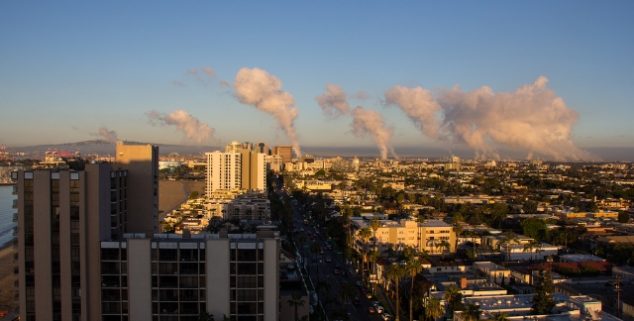Opinion
Spending cap-and-trade funds: Give priority to most vulnerable
 Pollution over Long Beach on a clear day. (Photo: Katharine Moore)
Pollution over Long Beach on a clear day. (Photo: Katharine Moore)Now that it’s reconvened, the state Legislature faces critical decisions about where and how to spend over $1 billion raised by the state’s cap-and-trade program to fight climate change. Those decisions will affect the lives, health and jobs of millions of Californians, and will have an outsized impact on those facing pollution and poverty.
Before their summer break, legislators passed and the governor signed into law key but imperfect pieces of climate change legislation, including AB 617 to improve air pollution monitoring and AB 398, which extends cap-and-trade to 2030. Now, the Legislature is tasked with spending over a billion dollars of cap-and-trade revenues on projects that will further reduce pollution and benefit the public. This includes directing crucial dollars in ways that will reaffirm the mandates of earlier laws, SB 535 and AB 1550, that direct a fair share of these dollars to projects that benefit underserved communities.
The frontline communities struggling with pollution and poverty have too often been shut out of decisions that affect every aspect of their lives.
This is the moment for legislators to stand up for the most vulnerable in California. They can do so by continuing to prioritize investments that include building affordable housing located near transit, helping low-income families weatherize their homes and save energy, planting trees in barren urban areas that now feel the worst effects of rising heat and pollution, and operating transit systems that get people to where they need to go with minimal emissions.
Programs like these can make lives better while helping to cut emissions of climate-changing greenhouse gases as well as the toxic pollution that damages lungs and shortens lives. They can also create good jobs in communities that urgently need them.
If additional revenue becomes available, the Legislature must also make investments in adaptation projects that can help communities cope with the daily impacts of climate change many Californians are already starting to experience, like increasing heat, drought and flood risks. Our representatives can also help ensure a just transition to clean energy, a transition that makes sure those who’ve made their living in fossil fuel industries don’t become roadkill as our economy shifts to clean power.
State leaders must also avoid the temptation to raid these greenhouse gas revenues for other uses, even when those uses are worthy. For example, the funds to implement AB 617’s ambitious air quality improvements must not come from raiding cap-and-trade moneys that could be improving the lives of Californians. Legislators can and should find other ways to fund AB 617.
And finally, state leaders must listen. The frontline communities struggling with pollution and poverty have too often been shut out of decisions that affect every aspect of their lives.
Legislators must make room for a genuine dialogue and fund projects that truly meet the needs of these communities. The state must also listen to concerns and warnings from local residents so that well-intended investments do not inadvertently further harm community members.
California has chosen to lead America’s fight against global warming. Now, we have to get the details right.
—
Ed’s Note: Alvaro Sanchez is environmental equity director at The Greenlining Institute. Chelsea Tu is staff attorney at Public Advocates.
Want to see more stories like this? Sign up for The Roundup, the free daily newsletter about California politics from the editors of Capitol Weekly. Stay up to date on the news you need to know.
Sign up below, then look for a confirmation email in your inbox.

California’s emission crusade began back in 2006 with the passage of Arnold Schwarzenegger’s Global Warming Initiative AB32. The public has been very supportive of that emissions crusade regardless of cost, as AB32 has raised billions of dollars from the public for the government.
So, in 2016 SB32 was approved that set the emission reduction goals of 40% below 1990 levels by 2030. Also in 2016, a companion bill AB197 said CARB should move away from Cap and Trade and toward more local command and control. Unfortunately the linked bills in 2016 of SB32 and AB197 would have been ultra-expensive as it placed much more emphasis on command and control through CARB’s regulatory authority.
Fortunately, in 2017 the passage of AB398 extended the cap and trade auctions to 2030 in the free market and took away most of the regulatory authority powers of CARB to meet those emission targets.
Even though AB398, that places the emissions crusade through the free market auctions is projected to be much more cost effective than the linked bills of SB32and AB197 command and control through CARB’s regulatory authority, the cap and trade “revenue generator” through 2030 provides the public with a dim forecast in the coming years as the burden of additional fuel costs will be falling completely on motorists and businesses.
The emissions crusade has however been very effective in hitting citizens’ pocketbooks to fund a multitude of governmental pet projects.
Speaking of equity and public policy, how does using hundreds of millions of cap and trade money on the high-speed rail project make any sense?
http://www.sacbee.com/news/politics-government/capitol-alert/article168777792.html